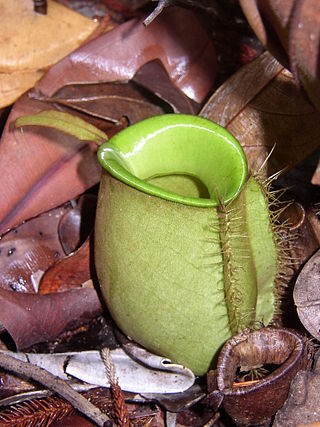
Nepenthes ampullaria is a very distinctive and widespread species of tropical pitcher plant, present in Borneo, the Maluku Islands, New Guinea, Peninsular Malaysia, Singapore, Sumatra, and Thailand.
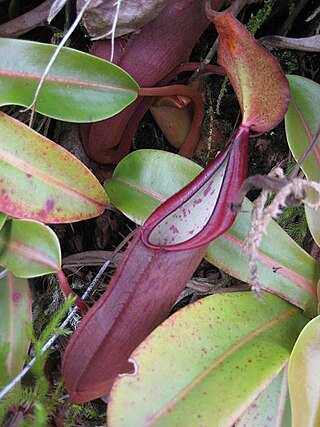
Nepenthes sanguinea is a large and vigorous Nepenthes pitcher plant species, native to Peninsular Malaysia and southernmost Thailand, where it grows at 300–1800 metres altitude. It is primarily a terrestrial species, but can grow as an epiphyte in the wet biome of upper montane forests. The pitchers are variable in size, from 10–30 cm tall, and range from green and yellow to orange and red. The insides of the pitchers are usually speckled with its two main colors. It was introduced to Victorian Britain around 1847 by Cornish plant hunter and botanist Thomas Lobb via the Veitch Nurseries.
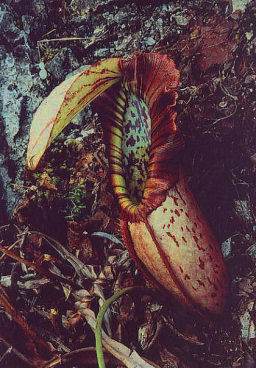
Nepenthes northiana, or Miss North's pitcher-plant, is a tropical pitcher plant endemic to Borneo, where it grows at elevations ranging from 0 to 500 m above sea level. The specific epithet northiana honours the English botanic illustrator Marianne North, who first depicted the species. Nepenthes northiana is one of the most famous Nepenthes, and its discovery in the latter half of the 19th century contributed to Sarawak's reputation as a land of spectacular exotic plants.

Nepenthes adnata is a tropical pitcher plant endemic to the Indonesian province of West Sumatra, where it grows at elevations of 600 to 1200 m above sea level. The specific epithet adnata is Latin for "broadly attached" and refers to the base of the lamina.

Nepenthes aristolochioides is a tropical pitcher plant endemic to Sumatra, where it grows at elevations of 1800–2500 m above sea level. It has an extremely unusual pitcher morphology, having an almost vertical opening to its traps. It is critically endangered by overcollection.

Nepenthes benstonei is a tropical pitcher plant endemic to Peninsular Malaysia, where it grows at elevations of 150–1350 m above sea level. The specific epithet benstonei honours botanist Benjamin Clemens Stone, who was one of the first to collect the species.
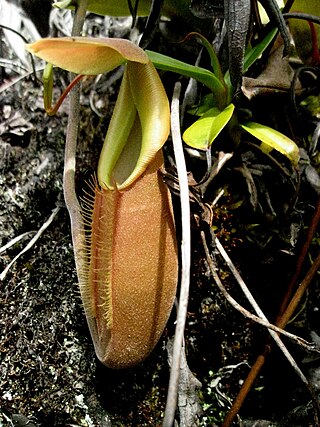
Nepenthes bongso is a tropical pitcher plant endemic to Sumatra, where it has an altitudinal distribution of 1000–2700 m above sea level. The specific epithet bongso refers to the Indonesian legend of Putri Bungsu, the spirit guardian of Mount Marapi.

Nepenthes jacquelineae is a tropical pitcher plant endemic to the Indonesian island of Sumatra. Due to its unique pitcher morphology, it is considered to be one of the most spectacular Nepenthes species native to the island.

Nepenthes dubia is a tropical pitcher plant endemic to the Indonesian island of Sumatra, where it grows at an altitude of 1600–2700 m above sea level. The specific epithet dubia is the Latin word for "doubtful".
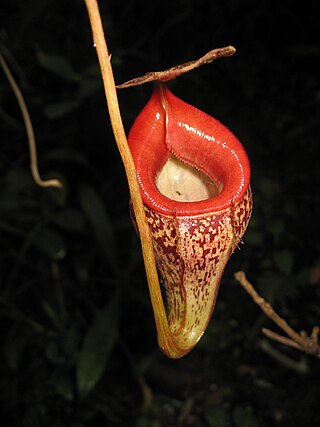
Nepenthes talangensis is a tropical pitcher plant endemic to Sumatra, where it grows in upper montane forest at elevations of 1800–2500 m above sea level.
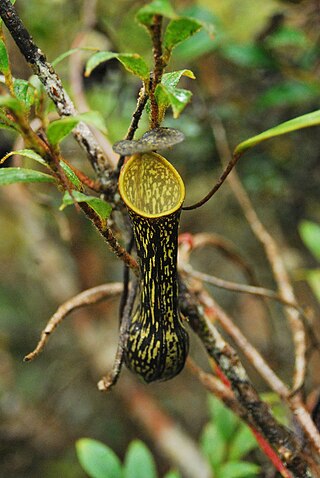
Nepenthes mikei is a tropical pitcher plant endemic to Sumatra. It is characterised by its black mottled lower and upper pitchers. The species is closely related to N. angasanensis and N. tobaica.
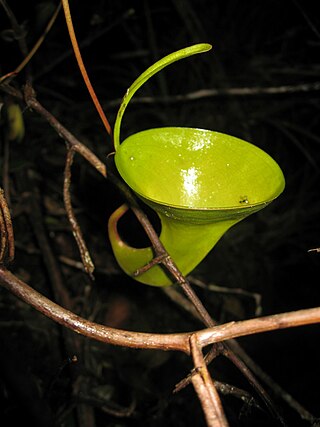
Nepenthes inermis is a tropical pitcher plant endemic to the Indonesian island of Sumatra. The specific epithet inermis is Latin for "unarmed" and refers to the upper pitchers of this species, which are unique in that they completely lack a peristome.
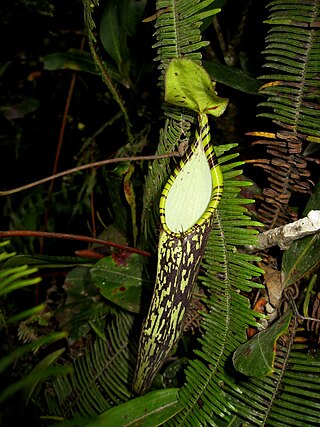
Nepenthes spectabilis is a tropical pitcher plant endemic to Sumatra, where it grows at elevations of between 1400 and 2200 m above sea level. The specific epithet spectabilis is Latin for "visible" or "notable".

Nepenthes junghuhnii is a tropical pitcher plant native to Sumatra. This species has been the source of much confusion since its discovery. The taxon originally named N. junghuhnii by John Muirhead Macfarlane has never been formally published. In 1994, taxonomist Jan Schlauer described N. junghuhnii as a "rather dubious species based on insufficient specimens". Nepenthes junghuhniisensu Macfarlane has not been relocated in the wild since the collection of the type specimen. It is characterised by strongly petiolate leaves and appears to be most closely related to N. bongso and N. spathulata; Schlauer considers it a possible synonym of the former.

Nepenthes kerrii is a tropical pitcher plant native to Tarutao National Marine Park in southern Thailand, where it grows at elevations of 400–500 m above sea level. The 2018 IUCN assessment also considers the taxon found on Langkawi Island of Malaysia to be conspecific. This species is thought to be most closely related to N. kongkandana. The specific epithet kerrii refers to Irish medical doctor Arthur Francis George Kerr, who made the first known herbarium collection of this species.

Nepenthes latiffiana is a pitcher plant species from Peninsular Malaysia described in the year 2020. It has been published in Webbia Journal of Plant Taxonomy and Geography in the first issue, volume 75, and made as the cover page for that issue. This species was described by Mohd Norfaizal Ghazalli (Ph.D), Amin Asyraf Tamizi and Dome Nikong, and name after a retired Professor of Botany from Universiti Kebangsaan Malaysia - Emeritus Professor Dato' Dr. Abdul Latiff Mohamad. The description was based on materials collected from a restricted area at the type locality in Setiu, Terengganu. Nepenthes latiffiana is characterized by a combination of green-yellowish-brown (peachy) coloration and several red blotches on its lower pitchers and light green upper pitchers that have 'flap-like' structures at the sides of the mouth due to expanded structure on the lateral sides of the peristomes.

Nepenthes domei is a species of carnivorous tropical pitcher plant native to Peninsular Malaysia, growing at 800–1000 m above sea level. The species' description was published in Webbia together with N. latiffiana, and it is one of the latest three new Malayan species described in the same year. These discoveries have now made Peninsular Malaysia home to 15 species of Nepenthes.
Nepenthes limiana is a tropical pitcher plant endemic to the northern Titiwangsa Range in Peninsular Malaysia. Nepenthes limiana was compared to Nepenthes sericea and Nepenthes sanguinea. The species differs from N. sericea by its upper pitchers being narrowly cylindrical which has an infundibular base with a pitcher hip on the lower part as compared to the wholly infundibular pitcher with a pitcher hip just below the mouth or pitchers that are basally infundibular turning cylindrical to slightly infundibular above the medial hip in N. sericea. Additionally, the narrowly oblanceolate to almost linear laminae that are slightly decurrent and the proportionally wider and bulbous peristome of the lower pitchers which are often flared and crenellated characterize this species from the sessile and oblanceolate to obovate-oblong laminae and the proportionally thinner peristome that are expanded near column only and not crenellated in N. sericea.





















